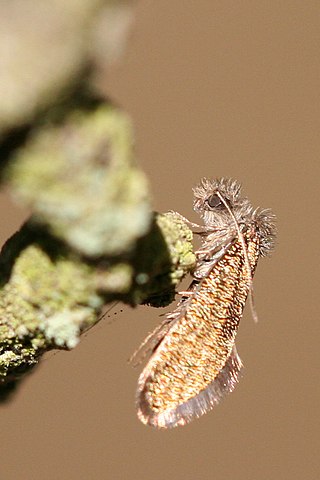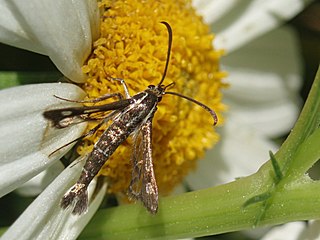
Pieris rapae is a small- to medium-sized butterfly species of the whites-and-yellows family Pieridae. It is known in Europe as the small white, in North America as the cabbage white or cabbage butterfly, on several continents as the small cabbage white, and in New Zealand as the white butterfly. The butterfly is recognizable by its white color with small black dots on its wings, and it can be distinguished from P. brassicae by its larger size and the black band at the tip of its forewings.
Northern root-knot nematode is a species of vegetable pathogens which produces tiny galls on around 550 crop and weed species. They invade root tissue after birth. Females are able to lay up to 1,000 eggs at a time in a large egg mass. By surviving harsh winters, they can survive in cold climates.

The common swift is a moth of the family Hepialidae. It was previously placed in the genus Hepialus. It is a common, often abundant European species. The species was described by Carl Linnaeus in his 1758 10th edition of Systema Naturae.

The foxglove pug is a moth of the family Geometridae found in Europe. It was described by the English entomologist James Francis Stephens in 1831.

The mottled umber is a moth of the family Geometridae. It is common throughout much of the Palearctic region. The species was first described by Carl Alexander Clerck in 1759.

Daphnis nerii, the oleander hawk-moth or army green moth, is a moth of the family Sphingidae. It was described by Carl Linnaeus in his 1758 10th edition of Systema Naturae.

Theretra clotho, the common hunter hawkmoth, is a moth of the family Sphingidae. It is found from Sri Lanka, India, Nepal and Myanmar, east through China to Taiwan, South Korea and Japan, and then south-east through South East Asia as far as the Lesser Sunda Islands and Timor in Indonesia. They can disperse long distances and may be found up to northern China. The habitat consists of open forests, forest edges, orchards, plantations, wooded scrubs, suburban gardens and city parks.

Dyseriocrania subpurpurella is a diurnal moth from the family Eriocraniidae, found in most of Europe. The moth was first named by the English entomologist, Adrian Hardy Haworth in 1828.

A crop wild relative (CWR) is a wild plant closely related to a domesticated plant. It may be a wild ancestor of the domesticated (cultivated) plant or another closely related taxon.

Tomares ballus, the Provence hairstreak or cardenillo, is a butterfly of the family Lycaenidae. It is found on the Iberian Peninsula, northern Africa and along the Mediterranean coast of France.

Mythimna separata, the northern armyworm, oriental armyworm or rice ear-cutting caterpillar, is a moth of the family Noctuidae. It is found in China, Japan, South-east Asia, India, eastern Australia, New Zealand, and some Pacific islands. It is one of the major pests of maize in Asia. The species was first described by Francis Walker in 1865.

Telegonus cellus, the golden banded-skipper, is a North and Central American species of butterfly in the family Hesperiidae. There are two populations, one in the eastern United States and the other in the southwestern United States and Mexico. The eastern population is rare and local and uses only one host plant, the thicket bean. The southwestern population is uncommon to common and uses more than one host plant. The golden banded-skipper is most active mid-morning and late afternoon. Their flight is sluggish and low to the ground, compared to closely related species.

Amyna axis, the oriental eight-spot, is a moth of the family Noctuidae. The species was first described by Achille Guenée in 1852.

Rheumaptera undulata, the scallop shell, is a moth of the family Geometridae. It was first described by Carl Linnaeus in his 1758 10th edition of Systema Naturae. It is found in most of the Palearctic realm and North America.

Pyropteron muscaeforme, the thrift clearwing, is a moth of the family Sesiidae. It is known from most of Europe.

Aproaerema anthyllidella is a moth of the family Gelechiidae. It is found in most of Europe, Kyrgyzstan, Iran and North America.
Fundella pellucens, the Caribbean pod borer, is a species of snout moth in the genus Fundella. It was described by Zeller in 1848.

Micrurapteryx caraganella is a moth of the family Gracillariidae. It is found in Siberia, and possibly Tajikistan and the Russian Far East.
Afidenta misera, is a species of lady beetle widespread in the Oriental region.

Amyna stricta, the eight-spot moth, is a species of owlet moth in the family Noctuidae. It is found in North, Central, and South America.






















